There is not much doubt that Jürgen Klopp is one of the world’s best coaches in the game. However, many only think of his Liverpool times although the German manager started way earlier and already had impressive years at Mainz and Dortmund before making his way to the Premier League.
In the following tactical analysis, we will depict Klopp’s tactical evolution from his time at Dortmund until his current reign at Liverpool. Therefore, we are going to reveal his famous “Gegenpressing” concept and how his attacking approach has changed over the years.
The importance of “Gegenpressing”
From a tactical perspective, Klopp’s Dortmund highly focused on the transition moments. Klopp especially attempted to bring the defensive transitioning of his team to perfection. His approach was to quickly press the opposition after losing the ball in order to regain possession. This concept is called “Gegenpressing” or counter-pressing. The idea lying behind the “Gegenpressing” is that the opposition is disorganised right after winning the ball as they need to transition from defence to attack. With a well executed “Gegenpressing” this disorganisation can be exploited and the ball can be won back.
In order to execute their typical counter-pressing, Dortmund attacked with a rather narrow shape. Dortmund would often build up their play through one side of the pitch. Their goal was to break through on this side or to regain possession after losing the ball with their compact shape. The sideline even increased the effect of the “Gegenpressing” as it decreased the passing options for the opposition. Below, we can see a counter-pressing situation where Dortmund can intercept the next pass after shutting down all passing options. After winning the ball, they can score the leading goal in the Cup final against Bayern Munich which they won 5-2.
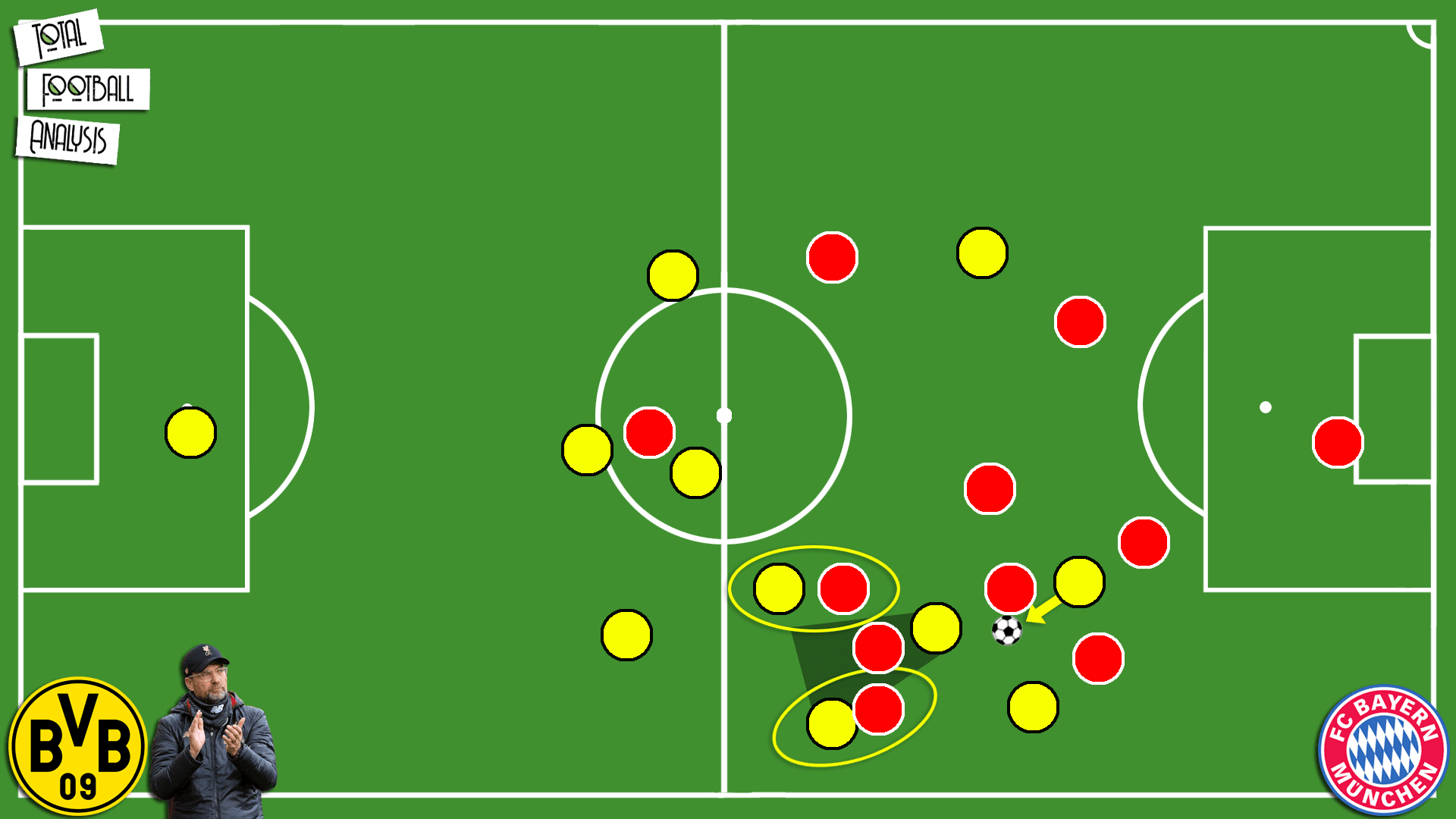
The overall goal of the “Gegenpressing” was to quickly counter-attack after a successful execution. Therefore, Klopp even once stated that “Gegenpressing is the best playmaker”. And Dortmund, indeed, often created chances after counter-pressing situations.
Depicting Liverpool now, one can clearly see that Klopp transferred this concept to his team at Anfield. Nevertheless, their attacking philosophy is slightly different which also influences their defensive transitions. Since their opponents are often satisfied with a goalless draw, Liverpool need to be more patient in possession. And with the opposition being more cautious after winning the ball, their “Gegenpressing” still remains important, but they are not offered as many counter-attacking opportunities after their “Gegenpressing” as during Klopp’s time at Dortmund. The aim has drifted towards the prevention of counter-attacks and the increase of possession. Instead of playing the ball forward with the first pass forward after regaining possession again, Liverpool more often secure possession with horizontal or even back passes since a penetrating pass is impossible.
The evolution of pressing triggers
But Klopp did not only change aspects of his attacking structure throughout the years. He also further developed his pressing strategy. Watching back old games of his Dortmund side, one can often see them setting up in a mid-block. In the following graphic, one can see them setting up in a compact 4-4-1-1 against Bayern. The two forward players were especially supposed to use their cover-shadows to prevent passes into midfield.
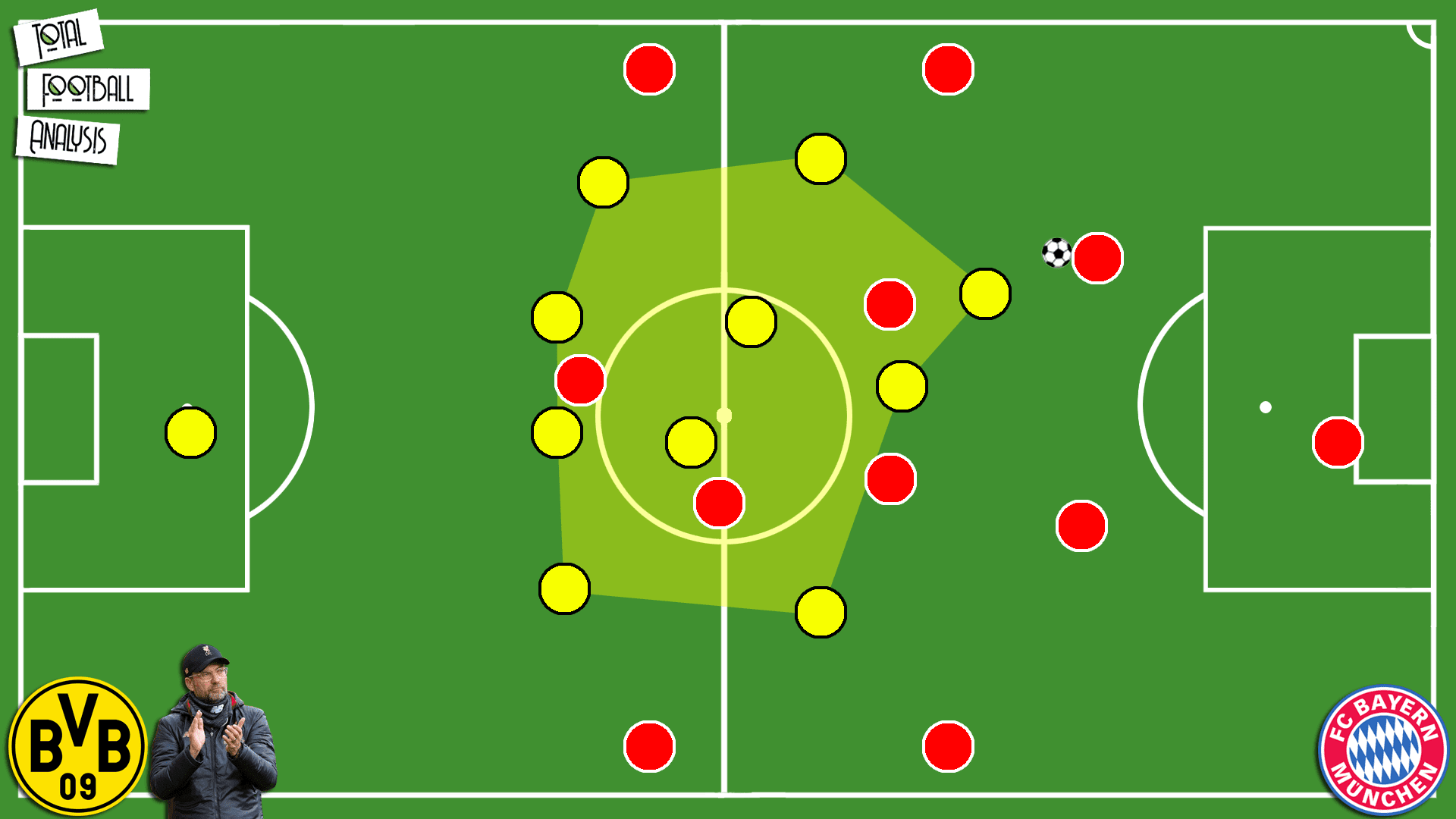
Dortmund prevented the opposition from playing any penetrative passes and started their press with certain triggers. A bad pass, miscontrol of the ball or a closed body shape of a receiving player meant that Dortmund’s players started to press the ball-carrier and shut down all short passing options. If the opposition played backwards to reset their attack, Dortmund would not necessarily continue their press though, which is different to the Liverpool side continuing their press and hunting for the ball. In Dortmund, Klopp already started to adjust his pressing approach to a one that comes close to Liverpool’s current strategy to guide the opposition build-up inside with a 4-3-3.
One of Dortmund’s defensive strengths was how the wingers tracked back once being overplayed. Therewith, they could often outnumber the ball-carrier near the sideline and stop the opposition attack.
At Liverpool, Klopp’s pressing approach has become even more proactive. Although Liverpool are also sometimes using the advantages of a mid-press as well, they mainly use this to set up their pressing traps.
Moreover, as Liverpool press higher than Dortmund, horizontal passes are also used as a pressing trigger. They enable the winger to start the press forcing the centre-back to play the ball back inside. That is supposed to reduce the width of the opposition build-up play. Obviously, this changed pressing approach also required a change of the setup. Contrary to their rather flat 4-4-1-1 / 4-4-2 shape in Klopp’s early time at Dortmund, Liverpool use a 4-3-3. The ball near winger will often press the centre-back and guide the opposition build-up into central areas. Therefore, Liverpool’s attackers use their cover-shadows similar to Dortmund’s players during their press, as one can see below.
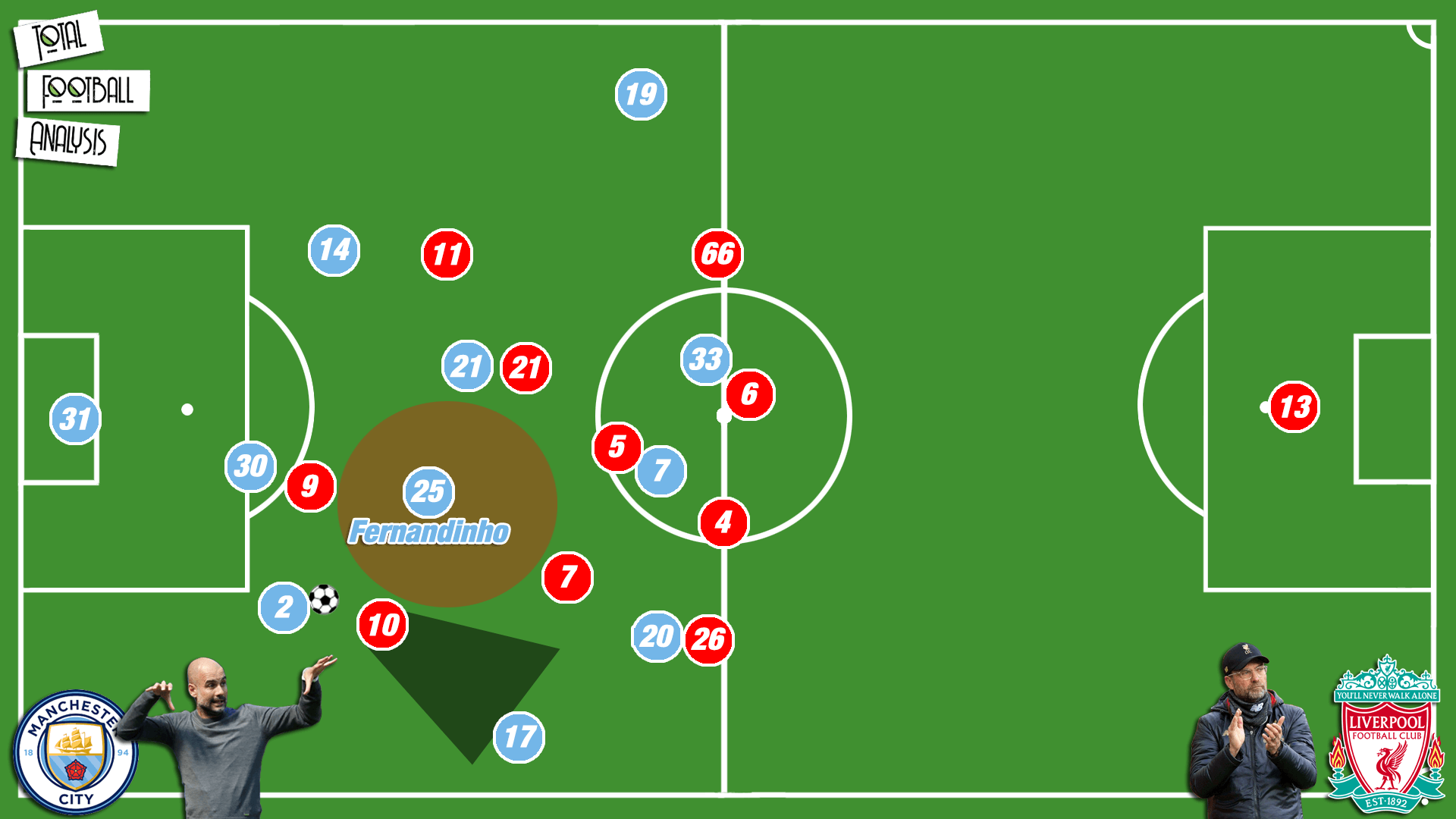
This pressing trap admittedly allows the opposition midfielder, in this case Fernandinho, to receive the ball, but enables Liverpool to then press the opponent from different directions though.
Notice in the following image how a Liverpool midfielder can press Fernandinho from the blind side once the pass is played.
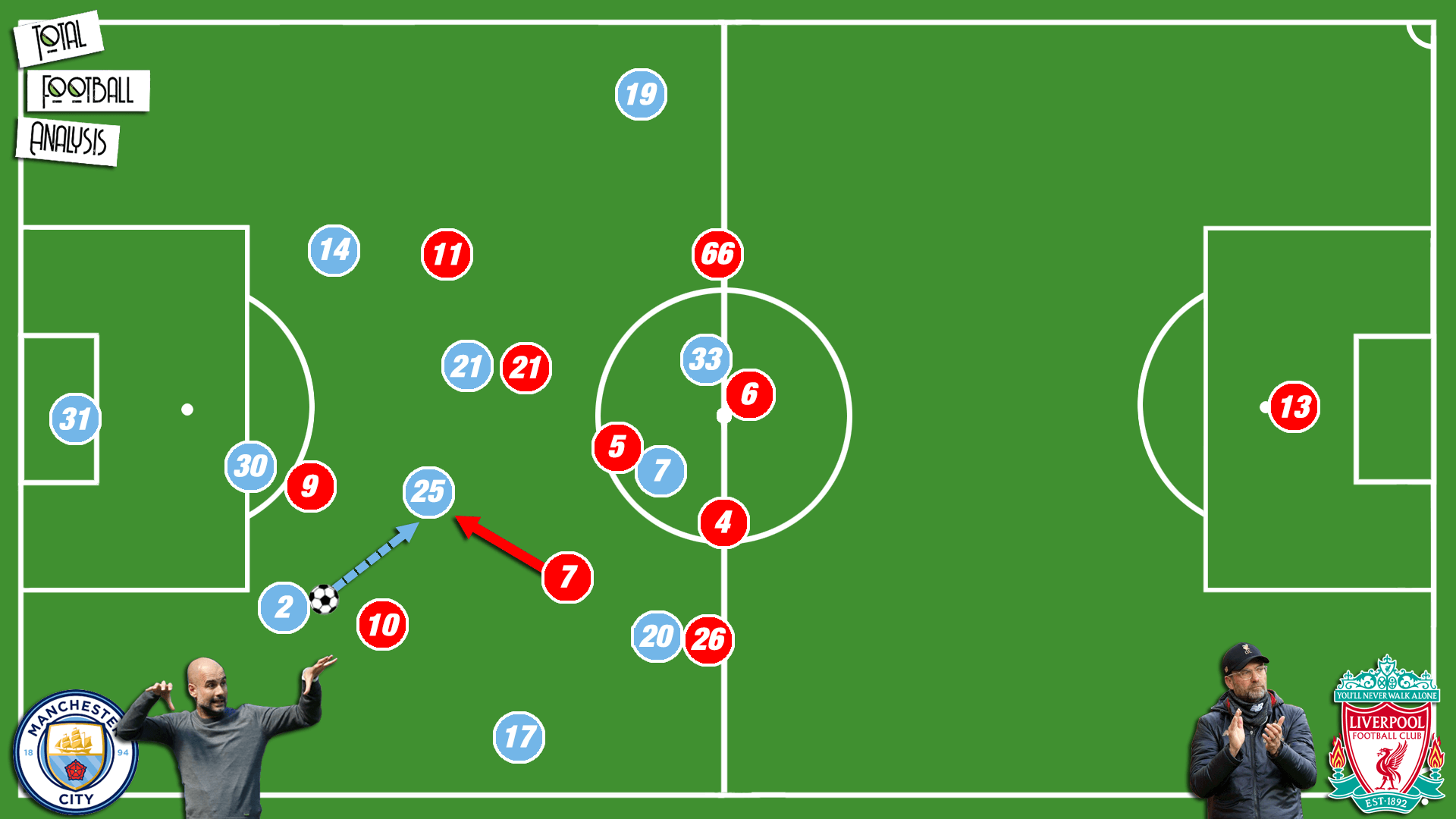
But Liverpool’s press requires their full-backs to defend higher in order to press a potential ball towards the opposition full-back. As a consequence, Liverpool situationally create a back three when pressing Arsenal out wide. As can be seen below, Liverpool’s right-back (#66) joins the press together with the striker (#9) and winger (#11). Meanwhile, the back line consists only of three players (#32, #4, #26).
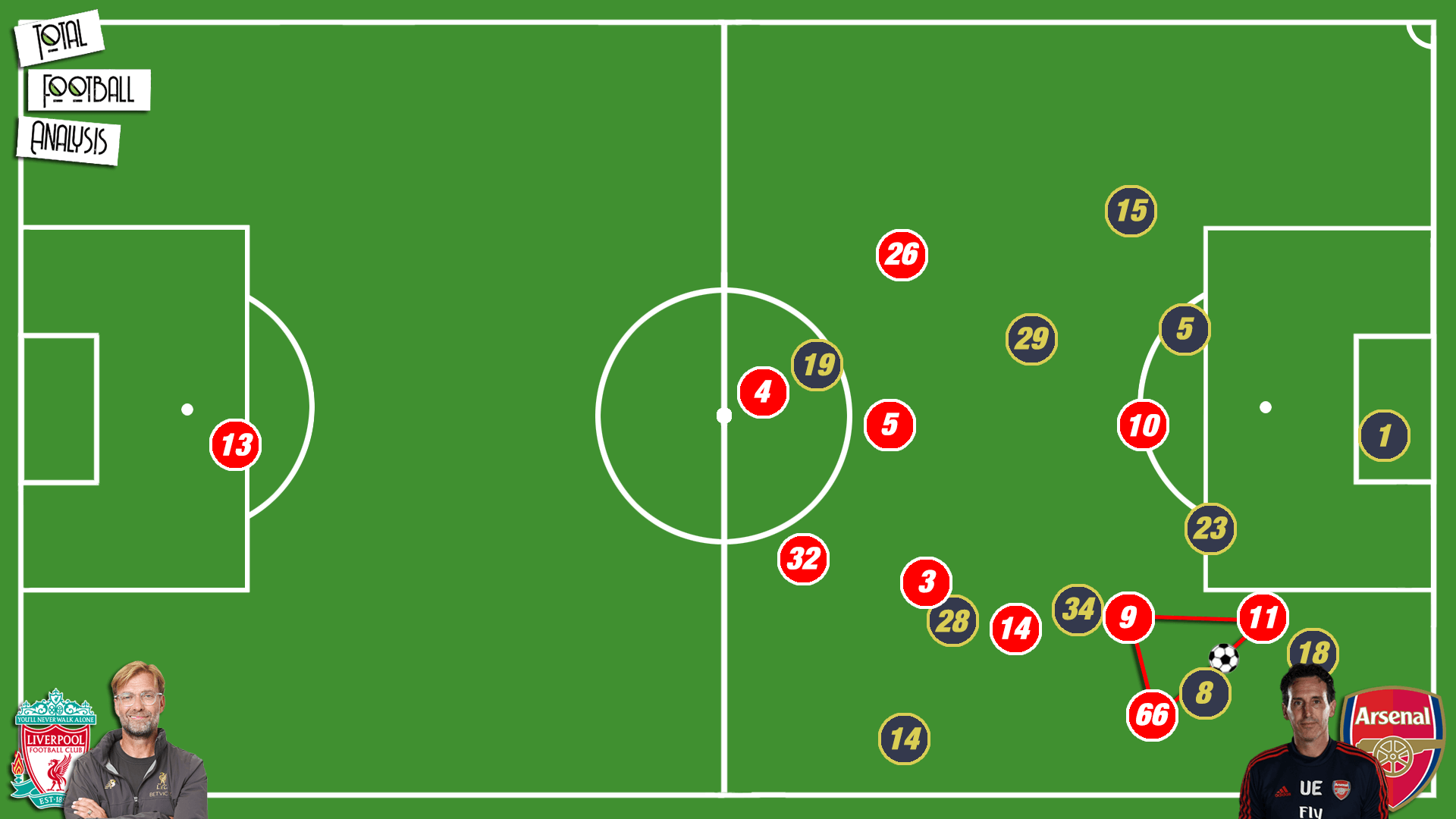
A principle that remained, however, is that the wingers constantly track back and chase the ball backwards. By supporting their midfield that way, the wide attackers are also vital during the defensive phase.
From number nine to false nine
Obviously, it is important to give players roles which suit their abilities. And Klopp has also understood this fact. While he deployed Robert Lewandowski as a rather classic number nine at Dortmund, he banks on Roberto Firmino as a false nine at Liverpool.
Lewandowski at Dortmund was utilised as a hold-up striker. The Polish international always offered the deepest passing option and was often found with longer balls. Either Lewandowski could hold up the ball and wait for his teammates to progress up the pitch or he could threaten the space behind the opposition defence himself. Since Dortmund’s attacking approach was rather direct, Lewandowski’s abilities were advantageous to their style of play. Moreover, he would be the main threat for their crosses from wide areas resulting from their dangerous wing play.
In Sadio Mané and Mohamed Salah, Klopp found two attackers which like to run deep and receive the ball in space. In order to create space for them, Firmino situationally drops into space between the opposition defence and midfield acting as a false nine. There, he can not only utilise his playmaking abilities, but also drag out defenders.
We’ve displayed a typical situation in the next image. Firmino (#9) drops and receives between the lines. If the opposition central defender (#25) follows him, that would open up a gap for Salah (#11) to start into. Due to the pace of Salah, the opposition defender (#5) would not be able to defend the deep run.
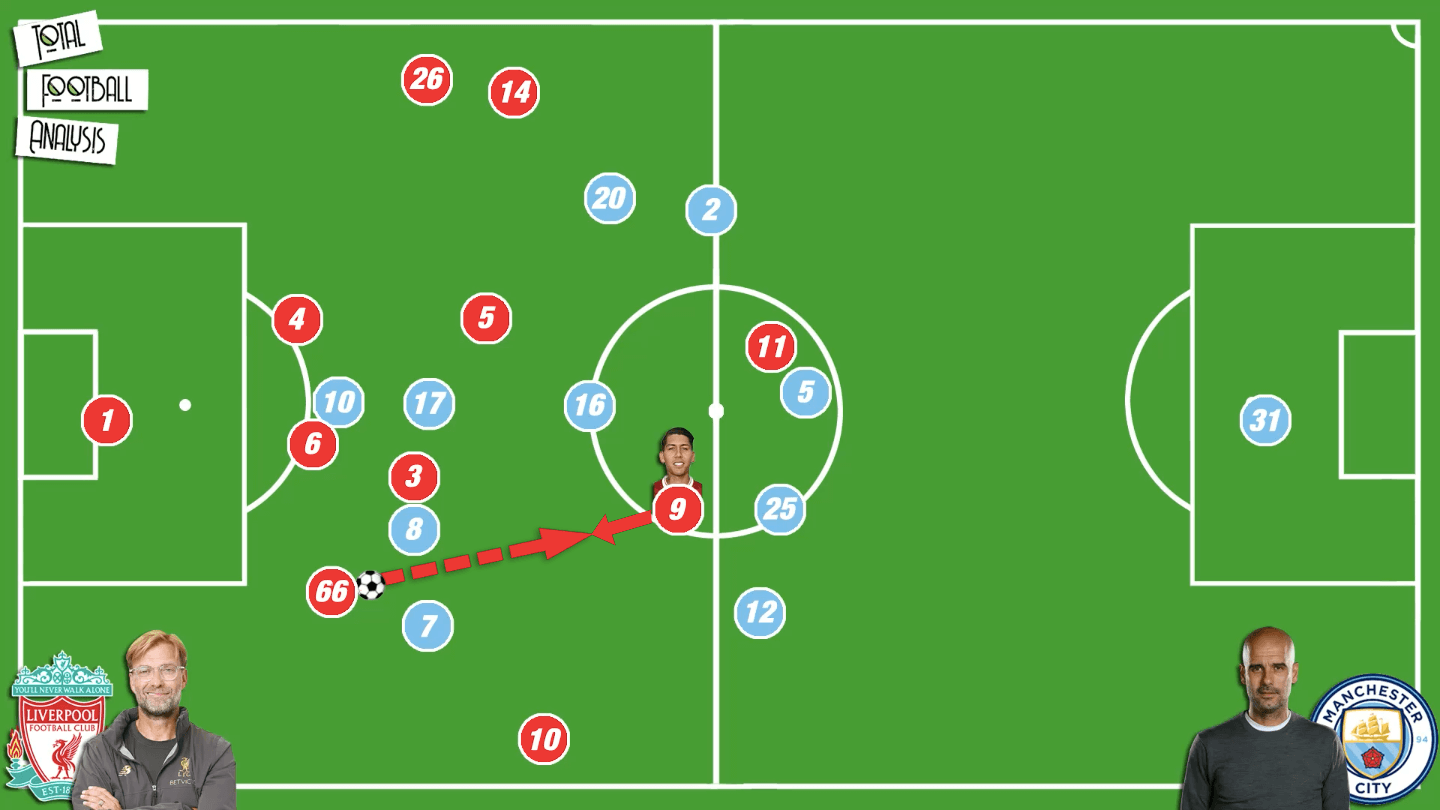
This part of the evolution shows, again, how Klopp always remains faithful to his principles while still rethinking his tactical systems with regards to his personnel.
Attacking versatility as the key improvement
The fact that Klopp’s Dortmund was a bit more passive than his current side, allowed him to create a majority of their chances through quick counter-attacks. At Liverpool, however, most teams will let Liverpool build up the play while waiting for counter-attacking opportunities themselves. Therefore, Klopp was forced to further improve the outcome of their positional
attacks.
Compared to Dortmund’s narrow attacking shape with a lot of players shifting towards one side, Liverpool’s shape often overloads the centre of the pitch. The following image shows how eight of their players occupy the centre and the half-spaces against Barcelona. Only one player is positioned on each wing.
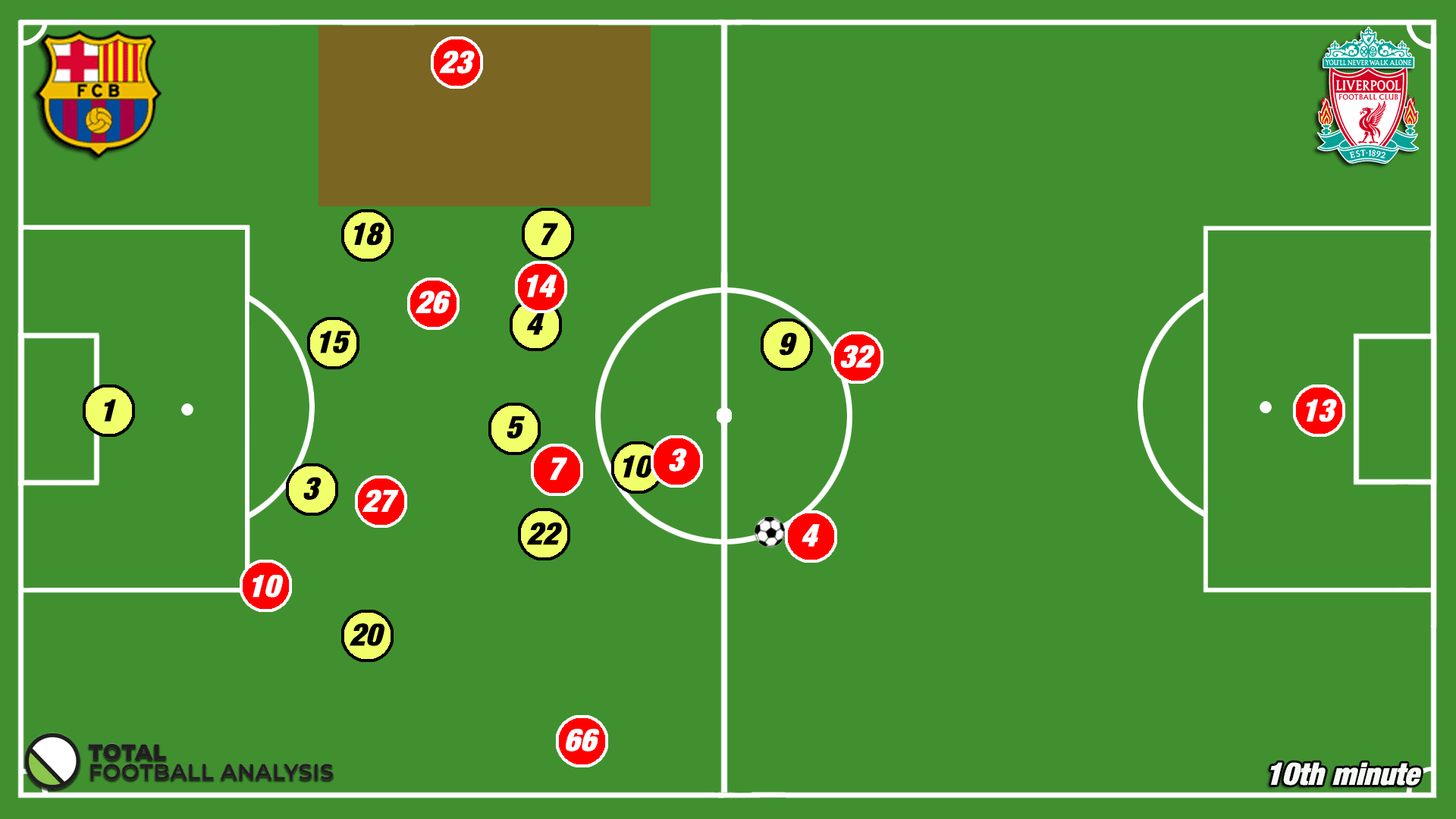
As a result, either they have a numerical superiority in the centre or they are given more space on the wings. In the above example, their wide player on the right is offered much space and able to receive the ball. Instead of deploying a static structure in possession though, the central midfielders would regularly rotate outside, allowing the full-backs to move higher. Alternatively, the central advanced midfielders can support the attack in wide areas. In some games, Klopp used his midfielders to create 2v1 situations with the winger against the opposition full-back. See below, how a 2v1 situation is created on the right wing.
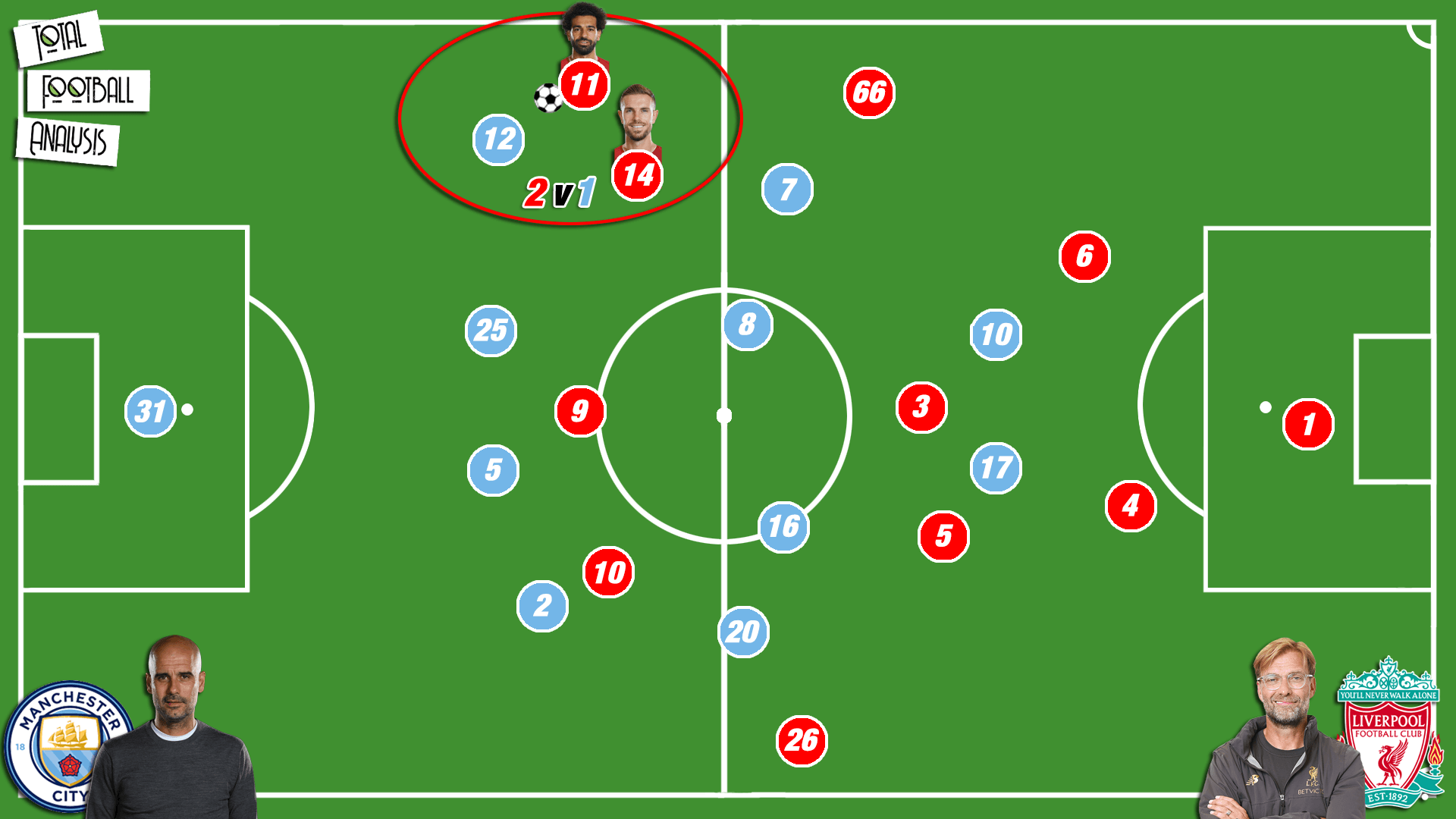
This versatility made Liverpool less predictable and therewith harder to defend against.
Furthermore, with the signing of Virgil van Dijk, Liverpool even gained more versatility during their build-up phase. Although Van Dijk’s most obvious strengths are his defensive abilities, the Dutch centre-back enables Liverpool to outplay the opposition press. Besides playing short combination play with his good technique, Van Dijk can play long diagonal balls with precision. This either enables the attacking trio to receive the ball in space or creates more space in the midfield since the opposition back line drops and thereby loses their vertical compactness.
But Klopp is also versatile in terms of the tactical system. From time to time, Klopp is pulling the rabbit out of the hat with an unexpected change. By lining up Salah as the centre-forward in front of Firmino as the number ten in a 4-2-3-1, for instance. This offers one more attacker to attack the three central channels. Nevertheless, independent of their formation, Liverpool’s full-backs play a key role during their positional attacks, as we will explain in the following paragraph.
The role of Klopp’s full-backs
Klopp is an advocate of the back four. He played with four man line in the back at Dortmund and this hasn’t changed at Liverpool. What has changed though, is how Klopp uses his full-backs in the attack. This is due to, both, his personnel on the full-back positions, and the tactical system deployed.
During his Dortmund time, the German coach favoured a 4-2-3-1 with a double pivot and a playmaker in midfield. One of the double pivot could join the attack in higher areas, while the other one would provide cover in front of the back line. As a result, Dortmund needed more than just their two central defenders to stay at the back. The ball near full-back supported the attack, while the ball for one stayed at the back, only progressing up the pitch when Dortmund were able to switch the play.
Since Dortmund followed a rather direct attacking style, the wingers tucked inside quite early attacking down the half-spaces. A problem which sometimes appeared due to this approach was that Dortmund failed to switch sides as there was no wide option ready to receive the ball on the far wing. Since the ball far full-back had no cover to move up the pitch, he could not take in the wide position. Below, one can see the explained structure during Dortmund’s possession phase. They have an overload on the right side which creates huge space on the left to exploit. The left-back, however, is positioned too defensively in order to provide an option to switch play. As a consequence, Dortmund fail to switch sides.
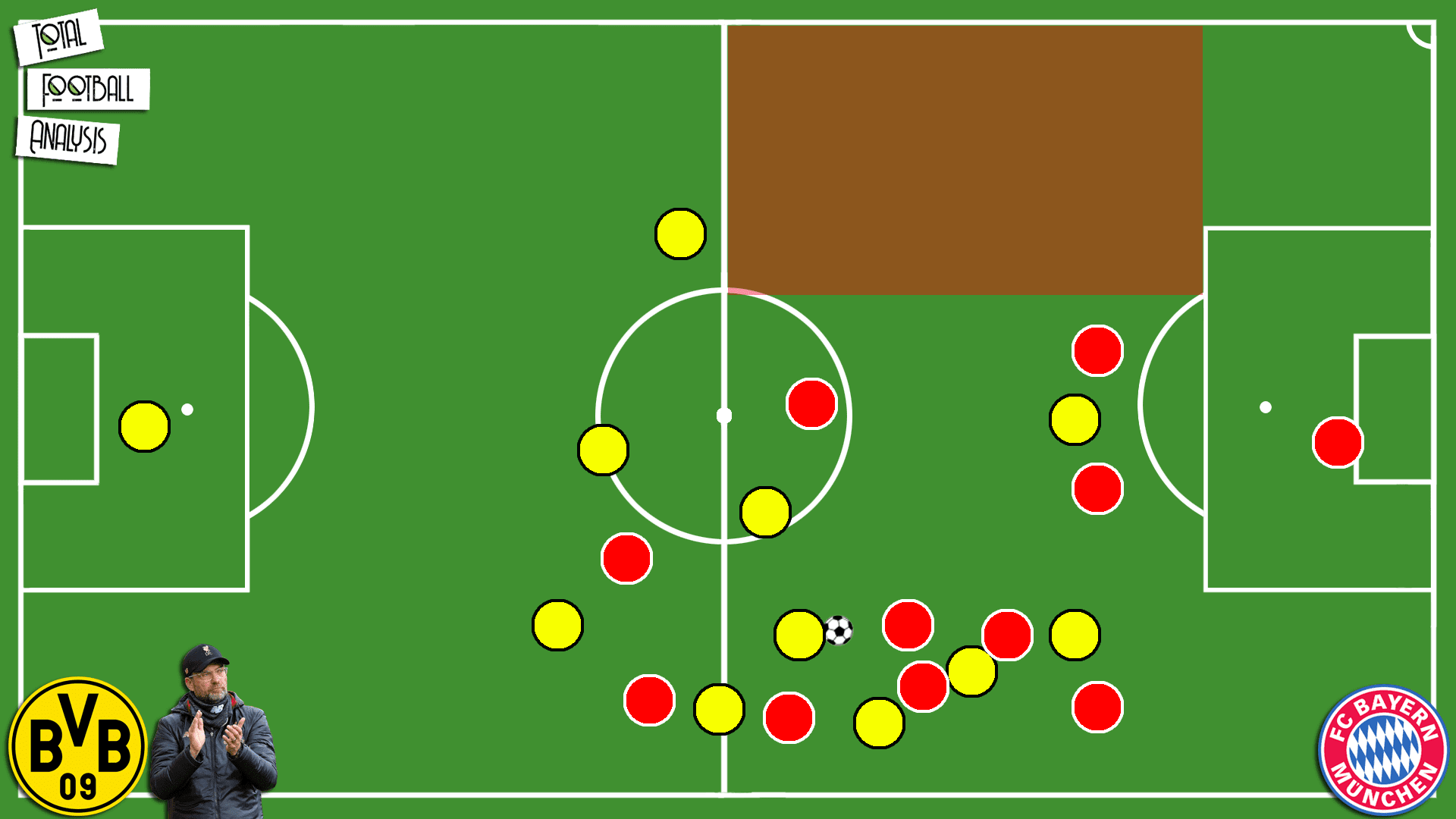
This is something Klopp fixed at Liverpool, however. He wants both of his full-backs, Andy Robertson and Trent Alexander-Arnold to attack high up the pitch at the English club. They were supposed to take over the role of the widest players during the attacking phase enabling Salah and Mané to attack down the half-spaces as displayed below.
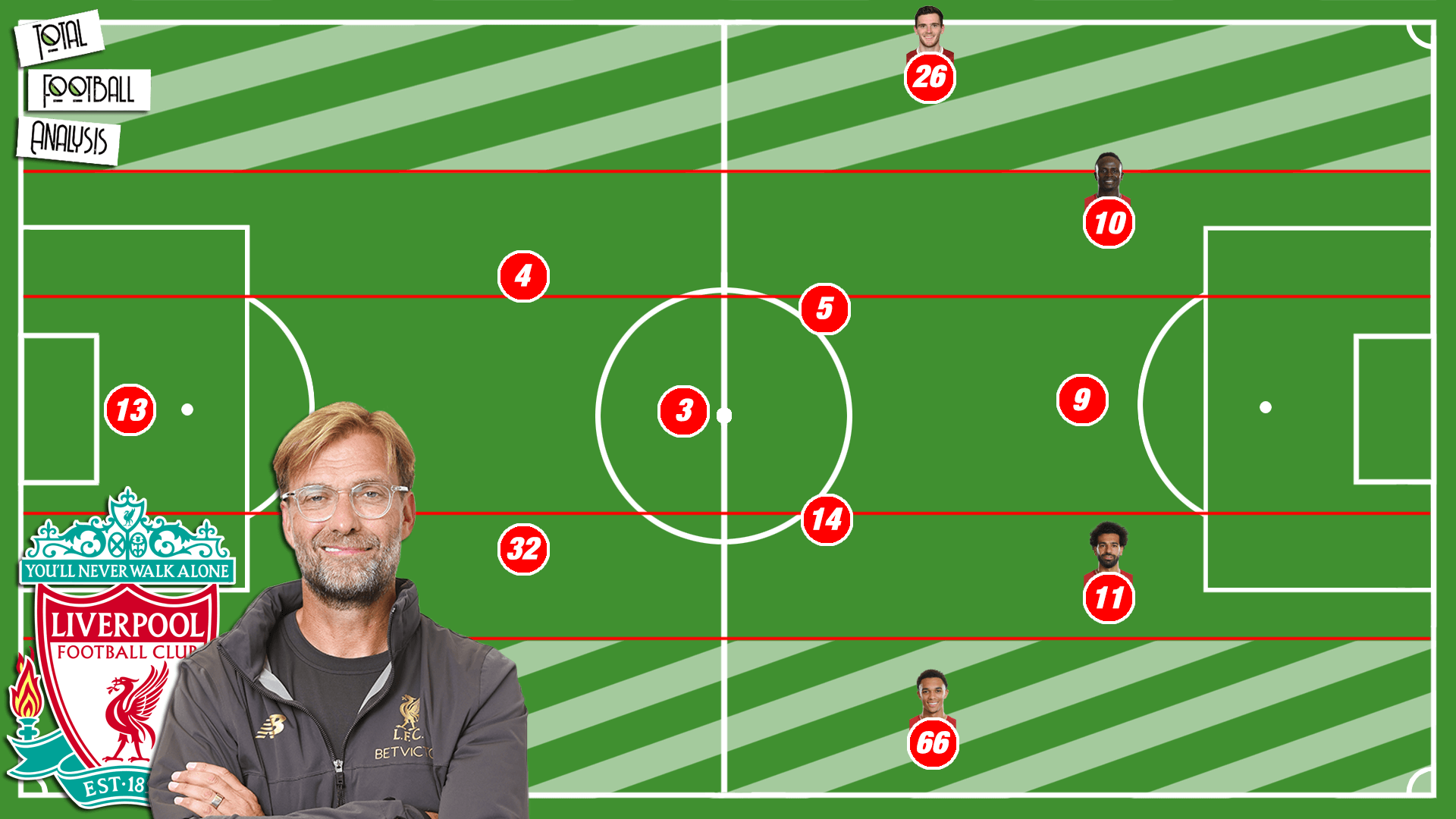
In order to ensure enough defensive cover, he changed the role of his midfielders. By often deploying a 4-3-3 with a holding midfielder and two advanced midfielders, his side has got more options to interchange positions in order to enable their full-backs to move higher. Often, either of the two advanced central midfielders would move behind a progressing full-back to cover the attack and to enable a shape which is advantageous for ball circulation. In the following graphic, we can see how James Milner (#7) takes in the left-back position allowing Robertson (#26) to move higher. On the other side, Jordan Henderson (#14) supports winger Salah (#11) while right-back Joseph Gomez (#12) positions himself more defensively. That way, Klopp’s side created 3v2 situations on the wing against Napoli.
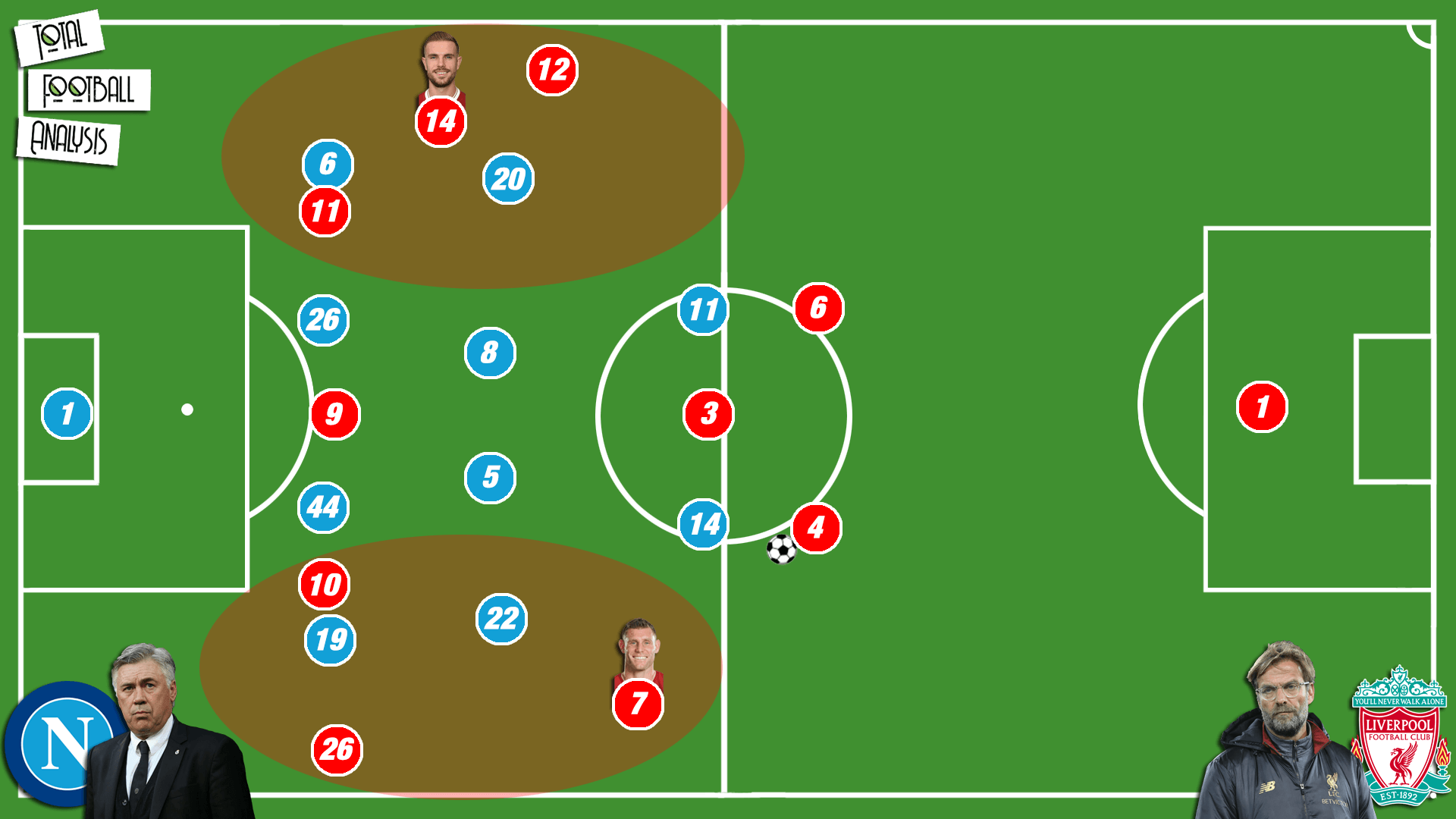
Furthermore, the high positioning of the full-backs allowed the wingers to tuck inside and attack down the half-spaces where they are most dangerous. This, again, is connected with Firmino’s role as a false nine, as already explained.
It is not a big coincidence that Liverpool create a huge amount of chances through crosses from their full-backs. Right-back Alexander-Arnold sent in an impressive total of 313 crosses in 2019/20 so far. Alexander-Arnold assisted 12 goals this season and left-back Robertson, as the second-best, counts 7 assists. While the “Gegenpressing” still remains an important part of Klopp’s tactics, one could even state that his new “playmakers” are his full-backs.
Conclusion
All in all, Klopp has always remained true to his principles but never stopped developing. Whereas the “Gegenpressing” still plays a key role within Klopp’s philosophy, his attacking style slightly changed. With more attacking versatility at Liverpool, Klopp has made his side even more threatening. Their improved attacking phase might have been the key factor for Liverpool’s current success.
To sum up, Klopp is innovative and is always seeking for areas to improve. And despite the heavy focus on his attacking and defending principles in our analysis, he also improved his set-piece strategies with the help of external coaches such as a throw-in coach. Therefore, one can be sure that this was not the end of Klopp’s tactical evolution yet.





Comments